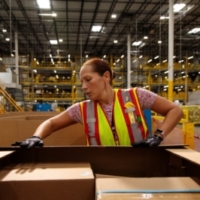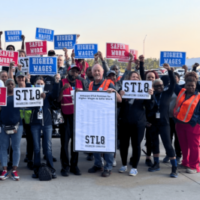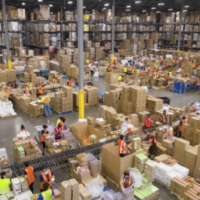Warehouse Jobs Should Be Good Jobs
Together with worker organizations, NELP is working to pass policies that build worker power and create higher-quality jobs in warehouses run by Amazon and others.

High-Quality Warehouse Jobs Are Central to a Good-Jobs Economy
In recent years, warehouse jobs in the U.S. have grown at a rapid pace. As the industry continues to expand, high-quality jobs in warehouses are central to a good-jobs economy.
In decades past, many warehouse jobs—especially in unionized workplaces—provided workers with good earnings and safe jobs, but that has changed with the rise of Amazon. Now the largest warehouse employer in the U.S., and the second largest employer in the country, Amazon has transformed warehouse jobs:
- Paying workers inadequate wages
- Encouraging high worker turnover
- Retaliating against workers who organize and speak up
- Using surveillance and technology to increase the pace of work, causing skyrocketing rates of injury
Amazon Must Do Better
Amazon has been at the forefront of developing automated (often referred to as “algorithmic”) management systems that combine secretive quotas and frequent discipline to push employees to work at unsafe speeds. Workers have described how these systems create a climate of fear and lead to high rates of injury.
Black workers are the backbone of Amazon’s warehouse operations. Black women represent one in six warehouse employees at Amazon. They bear the brunt of Amazon’s poor working conditions.
Warehouse workers are organizing to demand safe workplaces, higher pay, and greater transparency and accountability for Amazon’s outsized power in the U.S. economy.
NELP has helped worker organizations and unions across the country pass legislation that ends secretive quotas in warehouses and protects workers from retaliation. These laws help workers stand up to Amazon over unfair discipline and unsafe working conditions.
Strategies to Hold Amazon Accountable
NELP is working to advance four solutions that will help workers hold Amazon and other warehouse employers accountable for job quality:
Worker organizing and unionization: By forming strong unions and worker organizations, workers have more power to win higher pay, safer working conditions, and dignity on the job.
Expansion and enforcement of health and safety standards: Amazon must be held accountable for skirting health and safety protections. Also, lawmakers must adopt standards requiring employers to modernize equipment and worksite practices so workers stop getting hurt in warehouses. Protections for workers from the on-the-job environmental hazards that come with climate change—including heat but also cold, flooding, and excessive windstorms—should also be adopted.
Checks on automated “algorithmic” management systems: Secretive quotas and performance standards should not be allowed; employers should be required to share any data they use for write-ups. These transparency protections will lessen the climate of fear that leads to injuries and help protect workers from retaliation.
Ban on extreme surveillance practices: Amazon should be stopped from using practices such as “Time Off Task”—a monitoring system that tracks each second an employee is not doing a work task and penalizes them.
Pay and Working Conditions in Amazon Warehouses
less per month is paid to workers in counties where Amazon warehouses are located compared to similar counties without an Amazon warehouse.
per month in increased pay could be given to each of Amazon’s warehouse workers using just one-tenth of the company’s annual profit.
of reported injuries in Amazon facilities in 2022 were so serious that hurt workers could not perform their regular duties or had to miss work.
Worker Voice on Warehouse Work as a Temp
All stories
As a temp, they don’t care about your safety, or us as people. Everybody is expendable because the staffing agency can always get another person to work that position.
Testimony & Model Policies
Reports & Research
New Data Show Warehouse Injuries in New York Skyrocketing as Jobs in the Sector Continue to Grow

Blog
Amazon’s Outsized Role: The Injury Crisis in U.S. Warehouses and a Policy Roadmap to Protect Workers

Report
A Good Living: Amazon Can and Must Make a Middle-Income Livelihood Possible for the People Who Work in Its Warehouses

Report



